Introduction
Molded Case Circuit Breakers are used in power distribution systems as a high current protection and switching device. This article is all about molded case circuit breakers, known as MCCBs. We will be discussing MCCBs,their construction, types available along with their applications.
What is a Molded Case Circuit breaker?
Molded Case Circuit Breakers are one of the primary power handling devices available in industrial environments. MCCBs can also be identified as a ruggedized and superior version of domestic miniature circuit breakers. Miniature Circuit Breakers (MCBs) are primarily found in domestic power distribution boards to control electrical power applied to different circuits within a premise.
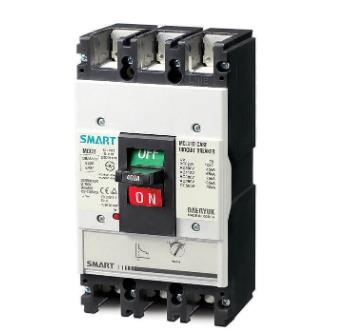
Molded case circuit breakers are primarily intended to be used as a power protection device. While a regular MCB used in a domestic distribution board has a current rating from 2A to 125A, a MCCB can have continuous current rating up to 2500 Amperes. This makes MCCBs an ideal choice for high power industrial applications.
These devices are also used as high current, low voltage power isolation devices to handle electric power and available to purchase in both AC and DC types. DC type MCCBs are more complicated than AC MCCBs due to the nature of arc that forms when a DC breaker disengages.
MCCBs provide similar features to that of MCBs such as,
- Switching action/power isolation
- MCCBs are also available in single-pole or three-pole configurations. This means that the MCCB can act as a switch that can completely or partially isolate the electrical system from the primary power source. This is a less common application of MCCBs.
- Overload protection
- Overload protection is the type of protection offered by an electrical safety device by automatically cutting off power if the connected load is drawing excessive current for a longer period of time.
- Electrical fault protection
- Faults such as line-to-ground fault or line-to-line faults can cause extremely large surge currents that need to be interrupted immediately. MCCBs are able to hold the maximum rated current while having instant shut-off capabilities for excessive surge currents.
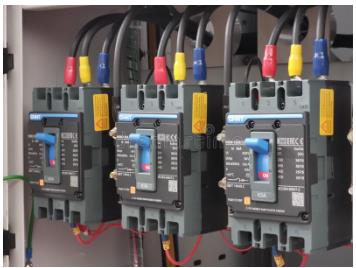
When compared to miniature circuit breakers (MCBs), molded case circuit breakers have a few added benefits such as,
- High voltage isolation
- Molded case circuit breakers are usually enclosed in larger plastic housings that can withstand high temperatures, shock and vibrations. They can be safely used in applications such as 400V or 600V where high voltage isolation is required.
- Programmable/adjustable thresholds
- In modern-day molded case circuit breakers, the parameters such as thermal overload protection temperature, overcurrent threshold, overcurrent trigger time and fault current can be adjusted. This simplifies the application of a MCCB model over a wide range of applications.
- Additional options
- MCCB manufacturers have started to include more advanced features such as remote sensing and monitoring for real time power consumption tracking and remote setting configuration. There are some brands that allow adding external accessories such as industrial communication network connectivity and alarms.
- Much larger current rating
- Molded case circuit breakers can handle high currents unlike MCBs. This makes them an ideal choice for power system protection in both industrial and domestic applications.
Molded Case Circuit Breaker Wikipedia
Molded case circuit breakers fall under the category of electrical power protection devices. According to Wikipedia, “A circuit breaker is an electrical safety device designed to protect an electrical circuit from damage caused by an overcurrent or short circuit. Its basic function is to interrupt current flow to protect equipment and to prevent the risk of fire. Unlike a fuse, which operates once and then must be replaced, a circuit breaker can be reset (either manually or automatically) to resume normal operation.”
In domestic, commercial and industrial applications where the system voltage is considered low (below 100VAC), MCCBs are used to handle currents up to 2500 Amperes. The characteristics for low voltage circuit breakers are further described in IEC947 standards definition.
The Wikipedia article found in this link contains additional information related to the types of circuit breakers and their theory of operation.
Before we discuss the types of MCCBs, let’s look at some of the common parameters of MCCBs.
MCCB Parameters Explained
| Parameter | Description |
| Rated Frame Current (Inm) | This is the maximum current that the MCCB can handle. This is typically the maximum value of the adjustable tripping current range. |
| Rated Current (In) | This is the breaker tripping current. This value is less than the rated frame current and is adjustable. |
| Rated Insulation Voltage (Ui) | Insulation voltage is the maximum withstandable voltage that the breaker housing can handle. This is measured under laboratory conditions. |
| Rated Operating Voltage (Ue) | Continuous operating voltage of the MCCB. This is the typical system voltage and can be lower. |
| Rated Impulse Withstand Voltage (Uimp) | Rated impulse withstand voltage is the voltage that the MCCB can handle during a surge event such as a lightning strike. The testing is standardized for a 1.2/50 microsecond impulse. |
| Short Circuit Breaking Capacity (Ics) | I_cs is the highest fault current an MCCB can handle without damaging the unit permanently. The device must always be used below this limit. |
| Mechanical Endurance | This provides an estimation of manual on/off cycles before the mechanical lever system fails. |
| Electrical Endurance | Electrical life provides a figure on how many times a unit can trip before it needs replacement. |
Molded Case Circuit Breaker Types
There are multiple types of molded case circuit breakers that are rated for different applications. We have 5 main categories of MCCBs that are used to satisfy varying current requirements.
- Type B MCCBs
- Type B MCCBs are the most common type of MCCBs found in distribution boards. They trip between 3-5x rated current. The trip time is adjustable from 40 milliseconds to 13 seconds. These are commonly used for subcircuit/resistive load protection such as lighting and heating elements.
- Type C MCCBs
- With a moderately high tripping current of 5-10x rated current, type C MCCBs are found in inductive load applications. The response time can be between 40 milliseconds to 5 seconds.
- Type D MCCBs
- Type D MCCBs are more suited for commercial and industrial applications where highly inductive and capacitive loads such as pumps and motors are used. They can withstand higher surge currents than B and C types.
- Type K MCCBs
- This type of MCCBs are mainly designed for industrial applications where high power motors are used such as mills and heavy machinery. The units are usually mounted at incoming or distribution boards.
- Type Z MCCBs
- The most sensitive type of MCCBs is the category Z. These trip between 2 to 3 times rated current. Type Z MCCBs are used to protect highly sensitive electronics such as medical instruments and semiconductor devices such as servers.
MCCBs are also classified according to the operation principle:
- Thermal-magnetic release MCCB
- This type of MCCBs rely upon the bimetallic expansion and the current balance in phases to trigger the contact. The inverse-time-tripping characteristic makes the thermal-magnetic MCCBs an ideal choice for residential and industrial applications.
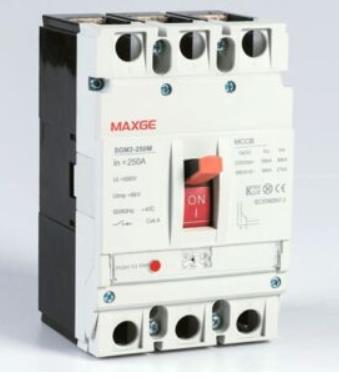
- Electronic Release MCCB
- This type of MCCBs have a separate power electronics circuitry that monitors the current flow and trips the switch accordingly. This is advantageous over thermal-magnetic MCCBs where electronic release MCCBs tripping performance isn’t affected by the ambient temperature.
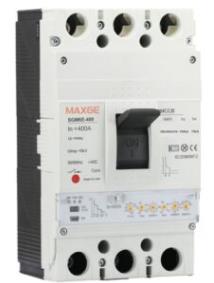
- Microprocessor Release MCCB
- Microprocessor type MCCBs have their own intelligent controller that dynamically monitors the current flow and other parameters. The current is measured in True R.M.S value therefore the detection performance can be fine tuned and controlled.
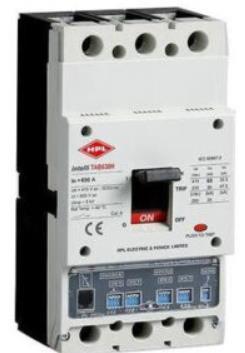
Molded Case Circuit Breaker Diagram and Construction
Let’s have a look at the internals of an MCCB. MCCBs are very similar to MCBs but are larger in size and thereby the current rating. Here’s a cross sectional diagram that shows the internal construction of a MCCBs.
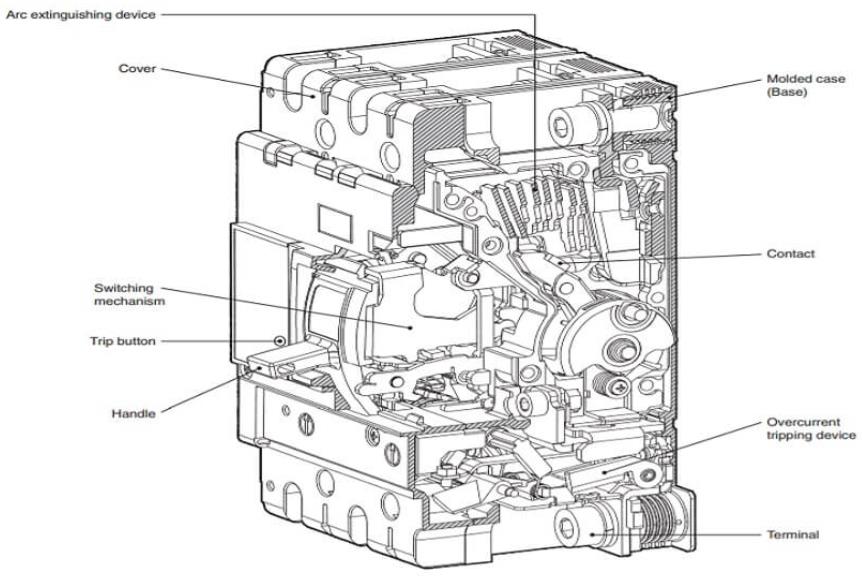
- Molded Case
- The MCCB get their name from the outer construction of the unit. This is generally a glass fiber reinforced, polymer-based housing. It has two parts and riveted together to form the internal contact housing.
- Overcurrent, Thermal Overload Tripping Device with External Handle
- The switching action is done by a spring loaded mechanism. This allows either manual or electrical operation. When the switch is set to one position, the mechanism locks the switch into a closed position.
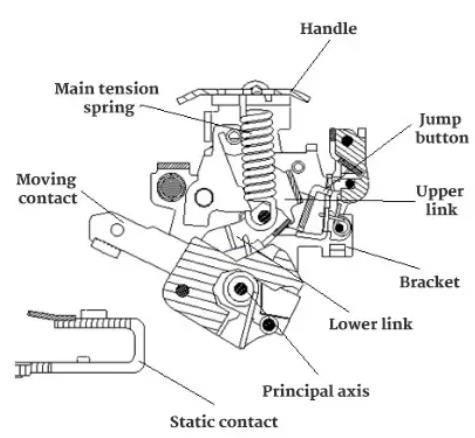
There is a thermal release and an overcurrent release coil placed in series with the main circuit. The undervoltage release is in parallel with the power supply. Similar to an MCB, the tripping mechanism consists of a bimetallic strip which expands as current flows through it. When the threshold is exceeded, it trips the tripping mechanism which releases the mechanical latch to break the contact.
- Arc Extinguishing Device
- The arc extinguisher is a specialized device that’s found on high-current MCCBs and Air Circuit Breakers. When a loaded electrical circuit is interrupted at a switch such as a MCCB, an electric arc is generated between the disconnected contacts. This is very common when interrupting highly inductive loads.
This electrical arc can ionize the air around it and can cause fire hazards and sometimes even personnel injury. This affects the material integrity of the contacts and the housing.
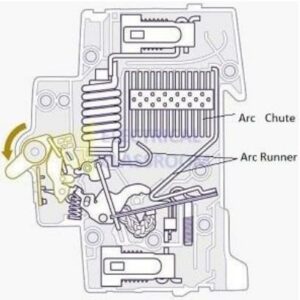
Arc extinguishing chamber plays a major role in terms of extinguishing such arcs. This consists of multiple air-gapped insulator plates that can be made of metallic or non-metallic materials. When the main contact opens, a blow of air blows the arc upwards and into the arc chute to increase the arc resistance and extinguish it rapidly.
- Connectors/Terminals
- There is a set of robust screw terminals that are physically isolated from one another to provide adequate high voltage isolation and current carrying capacity.
- Trip Button
- The manual trip button is available in most of the MCCBs for testing the functionality.
- Optional Communication and Remote Control Circuits
- More advanced MCCB models provide expandable options such as remote monitoring and control over the device. This is an optional part and can be purchased from the manufacturer and installed onto an existing base unit as an upgrade. The Siemens 3VAUL series is one such advanced MCCB with ETU (Electronic Trip Unit).
Functions of MCCB
MCCBs offer two primary functions:
- Overload Protection
- Short Circuit Protection
In addition to the primary functions, MCCBs also offer the following optional protection features.
- Earth fault protection
- Overvoltage protection
- Time delayed overcurrent protection
- Neutral current protection
- Differential ground protection
- Current imbalance protection
- Undervoltage protection
- Inverse current protection
Please note that the availability of the features mentioned above may vary from manufacturer to manufacturer or from model to model.
Moulded Case Circuit Breaker Price
Molded Circuit Breakers get expensive depending on their primary characteristics such as maximum continuous current. They usually start from $10-$20 and can cost you well into a few thousands of dollars based on the features such as remote control modules.
MCCB Application
Industrial, domestic and commercial premises all have main distribution boards (MDB). These distribution boards are the central points that distribute electrical power to the premises. MCCB acts as a main switch that routes power to the subcircuits in a distribution board while also providing overcurrent and short circuit protection.
In the picture shown below, you can see that there’s a high current MCCB at the top of the distribution board and from there, three more MCCBs receive power to control the subcircuits. While the smaller MCCBs provide protection in a subcircuit level, the primary MCCB acts as a main power switch that can cut off power to the whole system.
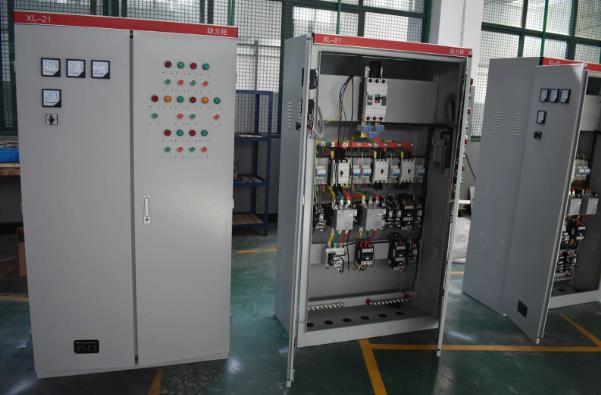
Conclusion
MCCBs have a similar functionality to a MCCB (Miniature Circuit Breaker) with added features and a much higher current capacity. While they are designed to trip in overcurrent conditions and protect the circuit, they typically spend their entire lives in closed position (turned on) with occasional triggers if any fault occurs.